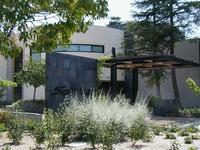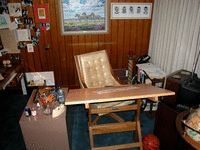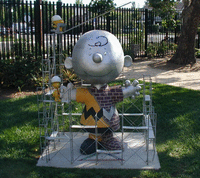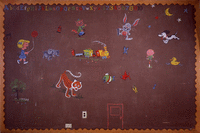A fan of the legendary “Peanuts” comic describes his pilgrimage to the Charles M. Schulz Museum in Santa Rosa.
Some Americans wait lifetimes to make pilgrimages to Gettysburg or Graceland. I made mine to Santa Rosa, California. Peanuts creator Charles “Sparky” Schulz moved to Santa Rosa in 1973 and ever since then, this city of 147,000 in California wine country north of San Francisco has been as associated with Schulz as with Chardonnay. And today it is the home of the Charles M. Schulz Museum and Research Center (707/579-4452), which opened in August 2002.
I don’t recall exactly when I first fell in love with Peanuts, but it had to be shortly after I learned that when two vowels go walking the first does the talking. It was before the first Peanuts television special, before Snoopy’s first battle with the Red Baron, before the introduction of Peppermint Patty and Marcy, before Charlie Brown became a household name. If I had been a Boy Scout I would have earned a merit badge in Appreciation of Subtle Humor.
Staying True to the Artist’s Life & Work
The opening of the Schulz museum was my main reason for journeying to wine country, since to me a glass full of wine will never measure up to a handful of Peanuts.
The museum is the centerpiece of Schulz land and the focal point for most visitors here. Actually, the real intent of the museum’s designers was to make sure Santa Rosa remained Schulz land, and not Schulzland. There would be no animatronic Snoopys, no “help Linus find his blanket” computer games, no virtual reality “play catch with Peppermint Patty” adventures. The emphasis here is on one thing: Sparky Schulz’s work.
Schulz’s son Craig says, “In reality, it was Jean’s [Charles Schulz’s widow] personal vision of the museum. Her idea was to keep it pure and simple and dedicated only to my dad’s art, to be genuine to him. It is meant to satisfy the thirst of true comic fans and Peanuts fans.”
While the upper floor of the two-story ode to comic angst is devoted to the man behind the comic strip, the ground floor is devoted to the strip itself, where it is treated not as pop culture but as art. Whether on walls or in display cases, nearly 50 years of original Schulz works are on view, arranged as rotating thematic exhibitions. Those who think Peanuts is just for kids should spend some time taking in the sentiments expressed in those ubiquitous thought bubbles in the vintage strips on view. Craig Schulz states, “My dad never saw himself as writing towards kids. The strip was more geared towards adults.”
A trip through the museum reminds visitors that Peanuts has always been cutting edge humor. Lucy’s psychiatric booth first appeared in the late 1950s when child psychology was a growing field. To social critics, Schulz was mocking the experts by saying their high-priced psychobabble was really worth five cents. In 1963, when credit cards and ZIP codes became parts of our lives, he introduced a character named “5,” whose dad felt that we are all losing our identity anyway so we might as well call ourselves by numbers.
Even after the Peanuts characters had become stars of television specials and Camp Snoopy theme parks they were spewing satirical spunk on the comics page. Schulz was a deeply spiritual man, as evidenced by the many times he quoted the Bible in his strip. But he had little patience for those who claimed to have all the answers. In a 1976 strip Snoopy is seen writing a book on theology called, “Has It Ever Occurred to You that You Might be Wrong?“ Schulz loved that punch line so much he used it again in 1980 when Linus concluded a Bible class by asking the teacher the same question.
Interestingly, Schulz never publicly admitted to making social statements in Peanuts. His good friend Cathy Guisewite, who draws the strip “Cathy,” said, “When people saw all sorts of meanings in his work, he would always kind of roll his eyes and say he was just trying to make his deadline. But I saw him as writing from the heart and soul. He created something millions of people could respond to in different ways. The whole spectrum of humanity could see something different in what he wrote.”
Two art works on display downstairs are not products of Schulz’s hands, but have everything to do with his creations. On the south wall is a remarkable mural crafted by artist Yoshiteru Otani measuring 17 by 22-feet and made entirely of 3,588 existing Peanuts strips on small ceramic tiles (pictured at left). The dark shades in the tiles form an image of Lucy holding a football as Charlie Brown runs to kick it. Another Otani work, the wooden bas relief “Morphing Snoopy,” is displayed nearby and is itself a wonder of art. It weighs over 7,000 pounds and consists of 43 layers cut away to reveal Snoopy’s evolution, from Schulz’s real life boyhood dog to the modern day dancing Snoopy.
Family Memories on the 2nd Story
The second story is the place to obtain insight into the philosopher who always defined himself as simply a cartoonist. A timeline and family tree exhibit tell Schulz’s professional and personal tales, and don’t neglect to notice the comment from cousin Irving Swanson, who said of the young man who seemed to do nothing but sit in his house and draw: “That boy will never amount to anything.”
The biggest stoplight on the second floor is a painted wall from the Schulzes’ early home in Colorado Springs, where they lived briefly in the early 1950s. Peanuts was in its infancy when Schulz painted toddler daughter Meredith’s bedroom wall. Subsequent occupants covered it, and present owners Mary and Stanley Travnicek had to remove four coats of paint to expose the images including a rubber duck, Tootles the train and the Saggy Baggy Elephant from “Little Golden Books” fame; alphabet letters, a little red door at the bottom and early images of Snoopy (on all fours), Charlie Brown and Patty. (Patty was one of the strip’s original four characters, as opposed to Peppermint Patty who would not be introduced until 1966.) A docent told us that Meredith recently came to the museum and confessed that all she remembered about the wall was the little red door. Where did it lead to, she wondered as a tot.
Schulz’s wood-paneled studio is also reconstructed here. Aside from the famous — to Schulz aficionados anyway — drafting table with the worn spot where the cartoonist etched and drew for over 20 years, is an eclectic collection of books: The Boy Scout Handbook, Beau Geste, The Herblock Gallery, The Great Gatsby, Wonderland by Joyce Carol Oates, a set of religious books, several volumes devoted to golf and even a few Peanuts books. His tastes in music were just as diverse; the albums stacked here feature the works of artists such as Nelson Eddy, Dave Brubeck, Buck Owens, Joan Sutherland, Brahms, Vivaldi, Handel. The closest thing to rock and roll is the “Jesus Christ Superstar” soundtrack.
“The studio is where there are probably the most emotional reactions,” says Craig Schulz of museum visitors, especially among area residents or those who knew Schulz. Personal family photos blanket the walls, including some of his parents back in his hometown of St. Paul, ca. 1920s, along with a painting titled “Springtime in Kenya,” by a fellow instructor at Schulz’s alma mater, Art Instruction Schools in Minneapolis.
Despite the museum’s intended serious purpose, there are a few diversions here. On the second floor is a room is set up for youngsters to draw their own comic strips. (What’s more hands-on than pencil and paper?) Peanuts animated specials often play on a television monitor there. A labyrinth in the shape of Snoopy’s head is outdoors; try to locate Snoopy’s eye, ear and nose. Environmental artists Christo and Jeanne-Claude, who have wrapped islands and other terrain across the world, wrapped Snoopy’s doghouse in ropes, a tarpaulin and polyethylene, and it is part of a permanent exhibit on the second floor.
In the museum courtyard is a sculpture of Charlie Brown, once one of a series which dotted the streets of Minnesota’s Twin Cities a few years back. While inspecting the statue look skyward. A sycamore tree holds in its leafy grasp a full sized, holographic red and blue kite, like the one Charlie Brown lost in so many kite-eating trees. At night the kite and string light up, as if to emphasize 50 years of frustration for Charlie Brown.
As the round headed kid would have said, “Good grief!”
For The True Fan: More Schulz Sites Nearby
True Peanuts fans know that Charles Schulz ate breakfast and lunch religiously at his favorite table in the Warm Puppy Café, part of the local ice skating arena called Snoopy’s Home Ice. It is located across a side street from the museum and was a gift from Schulz to the people of Santa Rosa.
Hockey playing Snoopys in stained glass decorate interior windows of the arena, and a jaunty Snoopy wearing a chef’s hat and holding a spatula dons an outside window of the Warm Puppy Café. Schulz’s favorite table, a diminutive thing as round as Charlie Brown’s head, still sits by the hearth, topped with a vase full of flowers and a marker reading “PRIVATE.” The café is a fine place for a sandwich, salad or cup of soup and a brief glance into Sparky Schulz’s world.
Be sure to take a walk outside the arena. In an ode to Mann’s Chinese Theater in Hollywood, athletes who have performed here have signed their names in cement. Included are Kristi Yamaguchi; Peggy Fleming Jenkins; Schulz’s daughter Jill, a talented skater in her own right; and skateboarder supreme Tony Hawk.
Snoopy’s Gallery and Gift Shop is the closest thing to nirvana for a Peanuts fan and also a handy place to buy something for the neighbor back at home watching your cat or taking in your mail. A short walk away is Coddingtown shopping center, one of Schulz’s favorite places to browse after a quick lunch at the Warm Puppy Cafe.
Following the lead of Minnesota’s Twin Cities, the community of Santa Rosa is showcasing this year 76 Woodstock statues scattered throughout the city, including some on the museum property. In May 2007, the Woodstock statues will be replaced by ones depicting Snoopy in his persona as Joe Cool.
Details, Details
The Charles Schulz Museum and Research Center is open year round. Memorial Day – Labor Day hours are weekdays, 11-5; Saturday and Sunday, 10-5. The museum is closed on Tuesdays the rest of the year. It is also closed New Years Day, Easter Sunday, July 4, Thanksgiving Day, December 24 and Christmas Day. Admission: $8 adults, $5 ages 4-18, college students with valid I.D. card and those 62 and over. Allow two hours, much more for Peanuts fans. Tip: step inside a restroom; the wall tiles are decked with classic Peanuts strips. I have heard of good bathroom reading, but never like this.
Special exhibits recently included “Peanuts On Ice,” with 70 original strips reflecting the Peanuts characters’ and Schulz’s love of ice skating and hockey. Future exhibits bring “Political Peanuts” from July 16th – December 1st, 2008, featuring the ups and downs on the campaign trail during the Peanuts’ 50-year run. Keep an eye out for “Schulz’s Beethoven: Schroeder’s Muse” from August 16, 2008 through January 26, 2009. Schulz painstakingly copied musical scores, note by note, with such accuracy that musicians can actually play the pieces directly from the comic strips.
Public skating is permitted at the Snoopy’s Home Ice (707/546-7147), formerly Redwood Empire Ice Arena, at varied times, usually for 90 minutes or more, and usually in the afternoon. Admission: weekdays $7 ages 12 and older, $5.50 ages 11 and younger; $2 skate rentals; Saturday and Sunday $9 ages 12 and older, $7 ages 11 and under; $3 skate rentals.
For Santa Rosa lodging, try one of the following: The Fountaingrove Inn, Hotel & Conference Center, (888/272/4998) at 101 Fountain Grove Parkway. Doubles are priced from $144/N-$350/N and include expanded continental breakfast and afternoon coffee and cookie service. The Gables Inn (800/422-5376, 707/585-7777) at 4257 Petaluma Hill Road is an eight-room B&B in a ca.1877 Victorian mansion. Doubles range from $175/N-$250/N, with a three-course gourmet breakfast and afternoon tea; also wine and cheese on Friday and Saturday evenings. The Days Inn (707/568-1011) is at 3345 Santa Rosa Avenue; here doubles are only $69/N-$149/N including continental breakfast.
For more information on the general area, contact the Santa Rosa Convention and Visitors Bureau (800/404-7673, 707/577-8674). The Welcome Center is located at 9 Fourth Street, Santa Rosa, CA 95401.
Dear Reader: This page may contain affiliate links which may earn a commission if you click through and make a purchase. Our independent journalism is not influenced by any advertiser or commercial initiative unless it is clearly marked as sponsored content. As travel products change, please be sure to reconfirm all details and stay up to date with current events to ensure a safe and successful trip.




